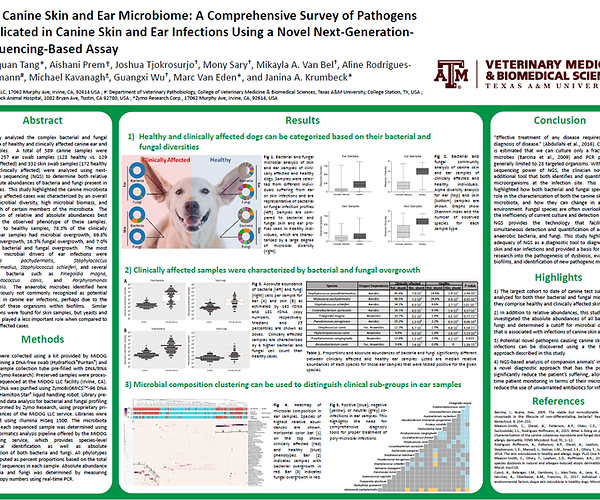
The MiDOG Test can help your vet to understand your puppy’s skin health
If you would have to guess, how many different bacteria and fungi live on our dogs’ healthy skin, what would you say?
The answer is hundreds [1]. There is a huge diversity of microbes, which you could imagine almost like a jungle. Many of these bacteria and fungi are commensals on the dogs’ skin, even forming a protective barrier against pathogens [2]. If there is an infection, however, such as atopic dermatitis or a wound, this number can be drastically smaller. There may even be only 2 or 3 different bacteria or fungi taking over 1. This has huge implications for the health of our dogs and unfortunately, we did not know very much about these organisms until very recently. Why? Because the vast majority of them don’t grow in the laboratory, so we couldn’t study them very well or didn’t even know that they were there [3].
Only if we know exactly which microbes are there and how many of them, we can understand how changes in the microbial composition, the microbiome, affect the dog’s skin and health [4].
For human skin, scientists have been studying for years what’s there, what are they doing and how can we use this knowledge to our advantage to effectively treat infections, acne, heal wounds, or even make us look younger [5]. This research was enabled by high throughput DNA sequencing, a technology that can discover all microbes in any type of sample. But for dogs and their skin? Not quite as much. Yet.
With the development of high throughput DNA sequencing as used by the MiDOG Test ®, we can know also better understand man’s best friend and his infections. The utility of DNA sequencing as a diagnostics test was recently shown in a publication in Veterinary Microbiology [1]. Never before was such a large cohort of dogs from all over the US tested for their skin microbiome, a total of 332. About half of these dogs were healthy, while the other half was suffering from a skin condition.
“We were able to show, that there was a distinct microbial profile separating clinically healthy dogs from those that were affected by the disease. We analyzed both the bacterial and fungal profiles and quantified the number of cells we found.” Said Dr. Janina Krumbeck, senior author of the study. “Fungal species play an important role in the characterization of the canine skin microbiota but fungal species are often overlooked based on inefficient culture and detection methods.”
Through their research, the group was able to discover the vast difference in microbial ecology between the skin of healthy and clinically affected dogs.
“We discovered many anaerobe bacterial species on the affected skin and even organisms that were traditionally not considered potential pathogens for dogs. Using a diagnostic approach as described herein veterinary medicine, could improve our understanding of the formation of polymicrobial infections or biofilms in canine clinical samples and their implications in disease” said Krumbeck.
Although there is still more to be done in characterizing the canine microbiome in health and disease, the results found this study signifies the potential of DNA sequencing methods for the accurate quantification and identification of bacterial and fungal populations in diagnosing canine skin infections, and highlight the limitations of traditional culture-based testing.
Read the full paper here.
Talk to your vet about MiDOG today.
Download the Full Poster:

The Canine Skin Microbiome
1. Tang S, Prem A, Tjokrosurjo J, Sary M, Van Bel MA, Rodrigues-Hoffmann A, et al. The Canine Skin and Ear Microbiome: A Comprehensive Survey of Pathogens Implicated in Canine Skin and Ear Infections Using a Novel Next-Generation-Sequencing-Based Assay. Vet Microbiol [Internet]. 2020;108764. Available from: https://doi.org/10.1016/j.vetmic.2020.108764
2. Rodrigues Hoffmann A. The cutaneous ecosystem: the roles of the skin microbiome in health and its association with inflammatory skin conditions in humans and animals. Vet Dermatol. 2017;28(1):60-e15.
3. Barcina I, Arana, Ines. The viable but nonculturable phenotype: a crossroads in the life-cycle of non-differentiating bacteria? Rev Environ Sci Biotechnol. 2009;8(3):254–5.
4. Rodrigues Hoffmann A, Patterson AP, Diesel A, Lawhon SD, Ly HJ, Stephenson CE, et al. The skin microbiome in healthy and allergic dogs. PLoS One. 2014;9(1).
5. Grice EA. The skin microbiome: potential for novel diagnostic and therapeutic approaches to cutaneous disease. Semin Cutan Med Surg [Internet]. 2014;33(2):98–103. Available from: http://www.ncbi.nlm.nih.gov/pubmed/25085669%5Cnhttp://www.pubmedcentral.nih.gov/articlerender.fcgi?artid=PMC4425451
Categories: Dogs, Ear Health, Pet Parents, Skin Health, Veterinary Dermatology

